
Hi Archinect!
I'm back at the GSD for a panel moderated by Shantel Blakely of Harvard GSD Public Programs called "Frontiers of Design Criticism." From the GSD website:
Today the feedback, spin, and other acts of interpretation that were once the preserve of historians and other experts are often virtual, instantaneous, and open to input from a broad audience. What does this mean? Mimi Zeiger, critic and journalist based in Los Angeles, will consider expanded models of architectural criticism and discursive platforms. Alexandra Lange, New York-based critic and 2014 Loeb Fellow, will explain why architects should use Twitter and Instagram to show their influences—what they read, the design pilgrimages they make, the colleagues they admire—not just to promote themselves. Florencia Rodriguez, editor of Plot (Buenos Aires) and 2014 Loeb Fellow, will explore the question of criticism's social or disciplinary responsibility; should it be “useful”? A discussion will follow, with GSD student writers and bloggers.
6:43: SB opens things up. "It's going to be a little awkward...we haven't done something like this before."
"How do we talk about design?" The aim of this event is to think a bit about design criticism and writing. SB did a poll of students about design criticism and the responses were concerned with how we can get discourse to be truly critical and also diverse--not just in terms of gender and ethnicity, but also geographically and socioeconomically.
There is criticism of design, and design as criticism.
6:48: Introductions of our three panelists: Florencia Rodriguez, Mimi Zeiger, and Alexandra Lange.
6:52: Rodriguez: Criticism is impossible. Foucault, in a presentation called "What's critique?" said that critique was "not being governed quite so much."
Critique has the goal of making things better; it comes from idealism.
Our relationship to time, space, and our daily agendas has changed over the past twenty years, largely because of the internet (ICQ, Facebook, Amazon, Wikipedia, Wordpress, etc.) The revolution is one from contained discourse to ambiguity.
Steve Krug's Don’t Make Me Think: A Common Sense Approach to Web Usability, published in 2000, led us to think about good design as unambiguous, leading us step by step without requiring much from users.
"I like to think of myself as an activist, though I don't use protest...what I do is try to shape ideas in a way that make it easier for people to [engage with a stronger commitment]."
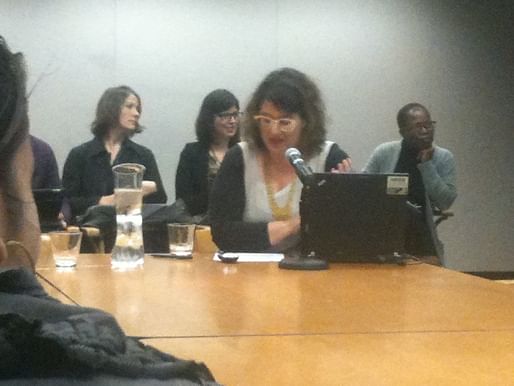
7:05: Zeiger (@loudpaper): I have to start with Furrrocious-Forms (architecture + lolcats),

because it would be too cheeky for me to start here, with the Ryan Gosling meme. 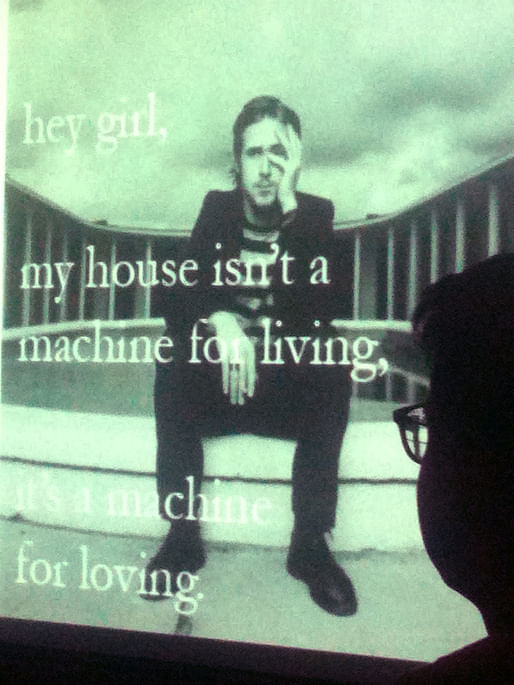
In 2010, Clay Shirky called this kind of effort "cognitive surplus," with our spare time invested in interaction--engagement, and not only consumption--online. The Arab Spring and the Occupy Protest are cited as results of this phenomenon.
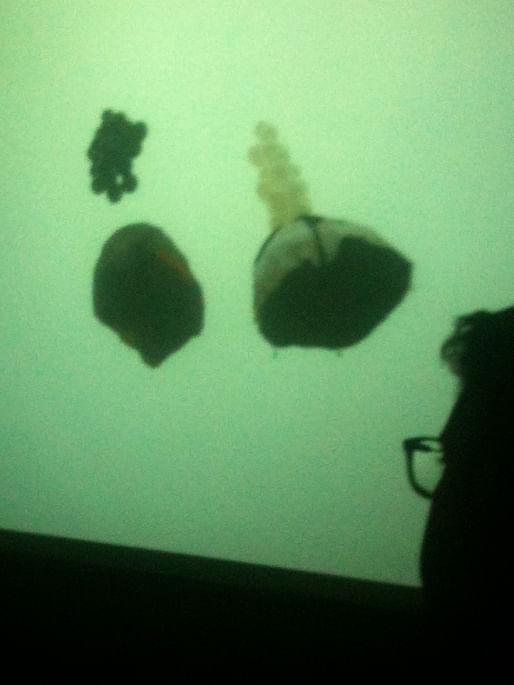
This can be understood as a kind of collective criticism. The power of Furrrocious-Forms is not in any one image but in the collection of them, generally created anonymously by all kinds of people.

Collective criticism bears a resemblance to crowd-sourced journalism, which turns reporting into a model of aggregated production. But it isn't about neutral or seamless outcomes, as in journalism. Instead, it's about dialogue and debate.

For example, Ethel Baraona Pohl started a conversation with a tweet, and a debate and conversation that was then posted this on her Facebook and on blogs, with the conversation between several people transforming with each change of platform.
The hashtag #FolkMoMA and the related tumblr was used to push back on MoMA's decision, using a photoshop competition and other means. Alan G. Brake, Executive Editor of the Architect's Newspaper, used the hashtag. Twitter becomes the grounds for even established media outlets to engage with people.
Last night in the workshop with GSD students, Zeiger had students critique critical texts, and then the group critiqued those critiques on Twitter, and the tweets were curated and made into a performance that will be put online "in a couple of months." "Or a couple of days."
7:27: Lange: "There's a rule that you should only tweet about yourself 30% of the time. That's a rule that architects break all the time, instead treating social media as an extension of their marketing. Happy happy happy, busy busy busy, me me me."
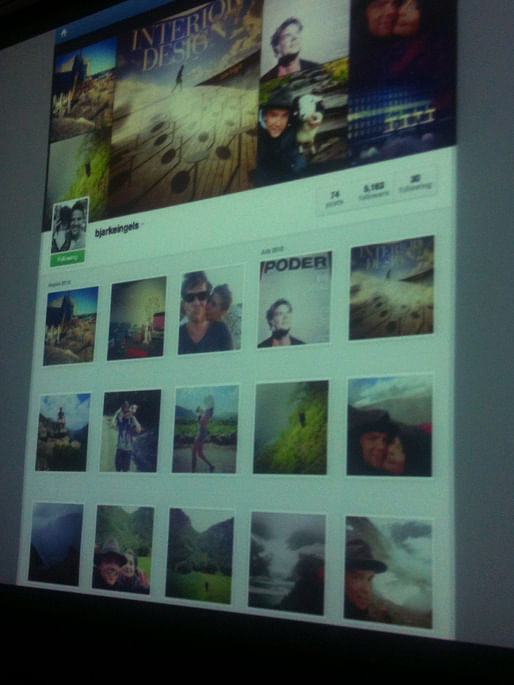
Most architects, in real life, aren't as monomaniacal as they seem in their tweets. They do other things, and have other interests, which inevitably influence and are a part of their architectural work.
 Philip Johnson would have been good at Twitter. He tried out his own history for the Glass House by writing about projects that he thought were of value. It was catnip for critics, then as now--and we can all use social media like this today.
Philip Johnson would have been good at Twitter. He tried out his own history for the Glass House by writing about projects that he thought were of value. It was catnip for critics, then as now--and we can all use social media like this today.
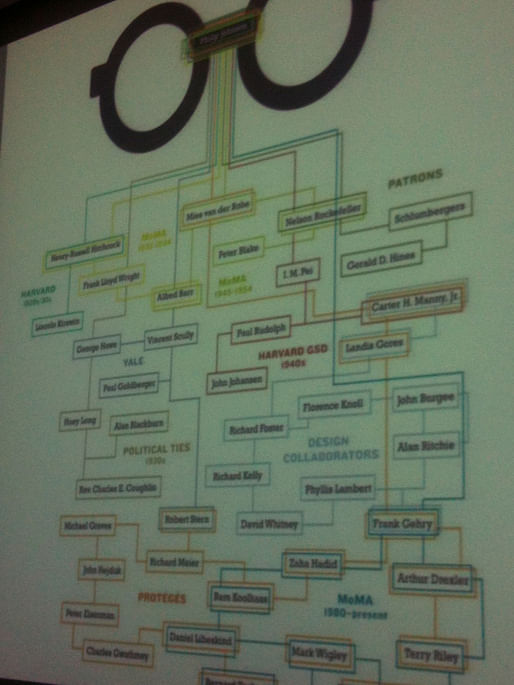
"In my own critical practice, I found it enriching to Instagram my visits to museums and buildings, as my first cut and take on things that I might not have time to write about. And my unprofessional photographs pick up on things other than the official photographs we always see." 
Iwan Bann uses Instagram. "I think there's something a little aggrandizing and aggressive about the aerial views, but there are also a lot of humanizing photos, with people. The heroic and humble are combined in his Instagram and I wonder if this will ultimately contribute to how we understand his work."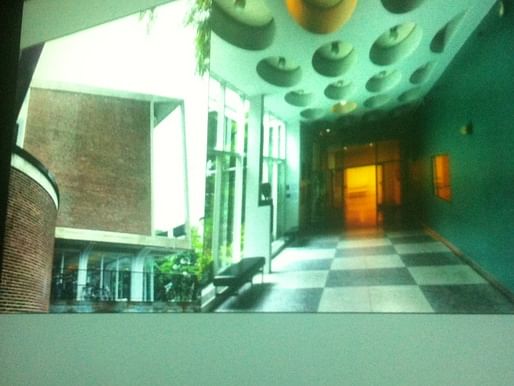
Social media can add context, before and after a project. On a campus, your building is likely to be in dialogue with...the whole campus. Social media can allow an architect to show a wider audience that they recognize that legacy and that they're looking carefully. Engagement with clients doesn't have to be limited to a specific forum.

And history: if architects don't speak for the quality and value of old buildings, then who will? In August, a group of twenty artblogs organized to spread the word about the Detroit Institute of Arts (which was under threat), asking people to post their own images of the collections and also to click through and buy memberships to support the institution.
Whereas twitter is omnivorous, tumblr blogs work best when they're honed to a very specific theme: eg. fuckyeahbrutalism.
This is what social media can do. As Swiss Miss says, start having conversations out loud and online.
Question from Dan Kaufmann (@dankauf): one thing that holds people back from starting to blog is the fear of posting something that you regret later. How to deal with this?
Question from Sekou Cooke: How do you deal with those who see online criticism as a lower form than print?
Another question: do people read anymore?
AL: I had one of the most terrifying experiences in my life when I published a piece attacking the critic of the New York Times; I thought my career would be over but that didn't happen. Before I published it, my mother said, "what have you got to lose?" As long as you write it well. In my experience, once you do it, you develop a rhythm and a voice, and you'll start to know what is suitable for your voice.
AL: As for print vs. online, for me if it's in print, it's as if it never happened. So it's generational. But having both is the most powerful.
MZ: I was live-tweeting Paul Goldberger's lecture at SCI-Arc last year, and ended up in--not quite a Twitter war--but...I had no regrets. In terms of print vs. digital, I don't have any bias towards one or the other at this point. I do print work, but what I'm most interested in, in more experimental pieces, is when something goes between print and online and live.
MZ: People read more now than they ever did. One issue of the NYT has more text than most people in the 17th century saw in their lifetime.
SB: What's the expiry date of criticism that comes out in social media? Banham, for example, argues that architects shouldn't design doorknobs and other items, because architects may think on a scale of 50 years whereas other designers think about designing something for a shorter duration.
AL: Social media definitely has a temporality; if you find yourself in a conversation that's already going on, you may not go back and figure out what's going on. But it becomes a mult-part sequence--from Twitter to a blog to Facebook to a print piece--and anyone can author the parts of these sequence. I'll often come back to something that started in one form and decide later to develop it into a written piece.
...
MZ: I feel like there's a fixation right now on "project," that it's something that every architect should have. And sometimes it's putting the cart before the horse; sometimes you need to develop a body of work before you know what it is.
AL: Florencia and I just got here as Loeb Fellows and people are always asking us what we're doing for the year.
One of my favorite platforms is readlist that allows you to drag and drop various articles to create your own collections. I started doing that with my own articles--when you're writing so much, themes start to arise that you weren't ever aware that existed. After I wrote ten articles about children and design and realized that I must be obsessed with it!
Ben Prosky, Assistant Dean of Communications, GSD: What is the place of criticism for institutions? Posting opinions on behalf of an institution--for many people--is very tricky.
AL: It doesn't have to be criticism but it does have to be interesting.
MZ: It's not necessarily about identity but about milieu; how does a Twitter feed create an atmosphere, rather than a voice, per se?
Question from Irene: For better or worse, when we're identifying ourselves as students of the GSD, what advice would you give to us to inject levity or humor into what we're saying, but also rigor and legitimacy--as people who don't have the following that you three have?
Question from Quardean Lewis-Allen: If you're trying to broaden your reach, you have to use a language that speaks to that audience--maybe memes for younger people. When you're watering down content to reach a different demographic, what are the tools use use in that case?
MZ: It can bridge between smart and serious, disarming, funny. But also identifying audience not as something that you "water down" or talk down to, but maybe using a language that is universal, descriptive, that has different textures so that there are ways in for different kinds of readings.
AL: I never think so strategically about anything. I feel like your audience finds you, not the other way around. You'll find the people who are interested in what you want to talk about.
End.
Thanks for reading!
Lian
This blog was most active from 2009-2013. Writing about my experiences and life at Harvard GSD started out as a way for me to process my experiences as an M.Arch.I student, and evolved into a record of the intellectual and cultural life of the Cambridge architecture (and to a lesser extent, design/technology) community, through live-blogs. These days, I work as a data storyteller (and blogger at Littldata.com) in San Francisco, and still post here once in a while.



7 Comments
Nice discussion, and great coverage. Thanks Lian!
Thanks Paul! My first time back at the GSD this semester! :P
hi
Twitter and Instagram are not the future of Design Criticism. Who are these people with so much time to be tweeting? Mean girls and PR departments.
Twitter is an endless series of drive-by shootings and lynch mobs with the attention span of flies. Don't you think that Twitter itself is worthy of criticism? Guess they didn't read the Franzen article.
Twitter and social media encourages superficial arguments. It is completely dependent upon old media outlets for real reporting. What these critics really want is architects to join twitter so they can try to social climb into their PR departments. Guess what, architects are too busy actually building real things in the real world (not their twitter following). Though, ironically, those that actually do are the ones that get followed.
The only way to get followed is to do or build something real. Rem Koolhaas could post his bowel habits and still get more 100x more followers then all of these people combined.
I don't think we can post any more articles about how unfair it is for women architects when this is what they are doing at the GSD -- oogling over pictures of cats, Ryan Gosling and Bjarke Ingels. C'mon now.
If I were a serious woman architect I'd have some harsh question for these panelists...
Great coverage Lian, thanks!
Block this user
Are you sure you want to block this user and hide all related comments throughout the site?
Archinect
This is your first comment on Archinect. Your comment will be visible once approved.